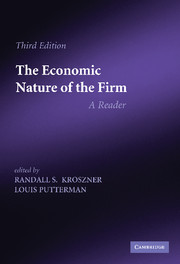Book contents
- Frontmatter
- Contents
- Editors' preface
- Reintroducing The Economic Nature of the Firm
- Part I Within and among firms: the division of labor
- Part II The scope of the firm
- 7 The nature of the firm
- 8 Vertical integration, appropriable rents, and the competitive contracting process
- 9 The governance of contractual relations
- 10 The limits of firms: incentive and bureaucratic features
- 11 Bargaining costs, influence costs, and the organization of economic activity
- 12 The boundaries of the firm revisited
- Part III The employment relation, the human factor, and internal organization
- Part IV Finance and the control of the firm
- References
10 - The limits of firms: incentive and bureaucratic features
Published online by Cambridge University Press: 05 June 2014
- Frontmatter
- Contents
- Editors' preface
- Reintroducing The Economic Nature of the Firm
- Part I Within and among firms: the division of labor
- Part II The scope of the firm
- 7 The nature of the firm
- 8 Vertical integration, appropriable rents, and the competitive contracting process
- 9 The governance of contractual relations
- 10 The limits of firms: incentive and bureaucratic features
- 11 Bargaining costs, influence costs, and the organization of economic activity
- 12 The boundaries of the firm revisited
- Part III The employment relation, the human factor, and internal organization
- Part IV Finance and the control of the firm
- References
Summary
Why can't a large firm do everything that a collection of small firms can do and more? That is a variant of a question asked many times before for which an adequate answer has never been devised – to wit, what is responsible for limitations in firm size? Yet another way of putting the same issue is this: Why not organize everything in one large firm?
The trade-off model in Chapter 4 [of Williamson (1985)] offers two reasons why a firm would eschew integration: economies of scale and scope may be sacrificed if the firm attempts to make for itself what it can procure in the market, and the governance costs of internal organization exceed those of market organization where asset specificity is slight. … The first is not a thoroughly comparative explanation. If economies of scale are realized by the outside supplier, then the same economies can be preserved upon merger by instructing the supplier to service the market in the future just as it has in the past. The fundamental limitation to firm size thus must turn on the governance cost disabilities of internal organization where asset specificity is insubstantial. But wherein do the firm's comparative disabilities in those governance cost … respects reside?…
A chronic puzzle
Frank Knight made early reference to the limitations to firm size puzzle when, in 1921, he observed that the “diminishing returns to management is a subject often referred to in economic literature, but in regard to which there is a dearth of scientific discussion” (1965, p. 286, n. 1).
- Type
- Chapter
- Information
- The Economic Nature of the FirmA Reader, pp. 127 - 142Publisher: Cambridge University PressPrint publication year: 2009
- 1
- Cited by



